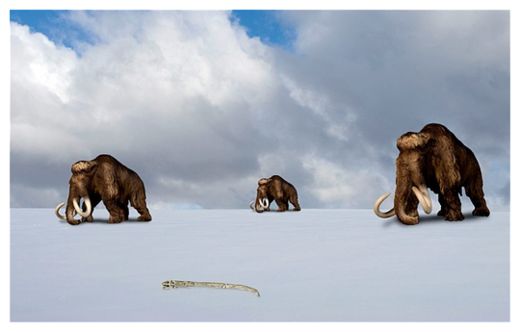
Studying deposits at 18 archaeological sites around the world they found tiny spheres of carbon they say are characteristic of multiple impacts and mid-air explosions from meteorite fragments.
They claim that millions of tonnes of dust and ash thrown would have been thrown into the atmosphere by the event, which would have choked the atmosphere and altered the global climate.
Their findings cast doubt on claims that it was human hunting that was responsible for the demise of large ice age animals like woolly mammoths, woolly rhinos and sabre toothed tigers.
Many scientists now believe that it was a combination of changes in the climate and pressure from human hunting that led to the mass extinction of many of these species.
However, the cause of the abrupt change in the climate between 12,800 and 11,500 years ago, known as the Younger Dryas by geologists, has been a controversial topic.
Dr James Wittke, from the Northern Arizona University in Flagstaff, who led the latest study, said: "The impact 12,8000 years ago is coincidental with major environmental events, including abrupt cooling at the Younger Dryas onset and major extinction of some end-Pleistocene megafauna."
An international team of scientists including Dr Wittke studied blackened carbon spheres at archaeological sites that are known to coincide with the end of the ice age.
They concluded that the spheres were formed by the melting of sediment at temperatures of more than 2,200 degrees C caused by heat and shock waves created by an "extraterrestrial object" passing through the atmosphere.
They also compared the spheres, also known as spherules, with similar items created in volcanoes, by lighting and human sources and found they did not match.
Their study, which is published in the journal Proceedings of the National Academy of Sciences, estimates that 10 million tones of spherules were thrown over an area of more than 19 million square miles by the meteorite fragmentation.
As well as large animals dying out around the time of the impact, there is also evidence for major human cultural changes, the scientists claimed.
Professor Kenneth Tankersley, an anthropologist and geologist at the University of Cincinnati who also took part in the study, said the changes appeared to happen 'within a lifetime'.
He said: "This likely cause climate change and climate change forced this scenario. You can move, downsize or you can go extinct.
"Humans at the time were just as resourceful and intelligent as we are today. With mammoth off the dinner table, humans were forced to adapt which they did to great success.
"It's a reminder of how fragile we are. Imagine an explosion that happened today that went across four continents.
"The human species would go on. But it would be different. It would be a game changer."



The Telegraph is so lame. First, only the resulting spherules would have been (very tiny) meteorites, after they fell to earth. The impacting body would have been a meteoroid.
Second, anything larger than 10 meters in diameter is traditionally called an asteroid (some modern astronomers term anything larger than 1 meter an asteroid), and anything weighing 10 million tons would definitely be termed an asteroid.
So approximately how big would that asteroid have been, if it weighed 10 million tons when it hit?
Let's assume it was a dense, iron-nickle asteroid, the heaviest that exist. Those have a density of about 7-8 g/cm^3, so say 7.5 g/cm^3.
1 ton = ~907kg and 907kg = 9.07 x 10^2 kg
10 million = 10^7 and 1 kg = 1 x 10^3 g
10 million tons = 9.07 x 10^9 kg = 9.07 x 10^12 g
9.07 x 10^12 g / 7.5 g/cm^3 = ~1.2093 x 10^12 cm^3
Our asteroid had a volume of over 1.2 trillion cubic centimeters! So how large in diameter was it?
volume of a sphere V with radius r: V = 4/3 x pi x r^3
with a little algebra and substitution...
1.2 x 10^12 cm^3 = 4/3 x pi x r^3
3/4 x 1.2 x 10^12 cm^3 = pi x r^3
9 x 10^11 cm^3 = 3.14159 x r^3
9 x 10^11 cm^3 / 3.14159 = r^3
2.86 x 10^11 cm^3 = r^3
the cube root of x = ~x^0.33
(2.86 x 10^11 cm^3)^0.33 = r
~6.034 x 10^3 cm = r and since diameter = 2r and 1 x 10^2 cm = 1 m
diameter = ~12.068 10^3 cm = ~120 m
If that was a heavy iron-nickle asteroid, it might have been only about 120 meters in diameter, or about the size of a football or soccer field, when it blew apart in the atmosphere or impacted the earth's surface.
Of course, it most probably was somewhat larger before it entered the earth's atmosphere and had much of its original mass ablated by heat.